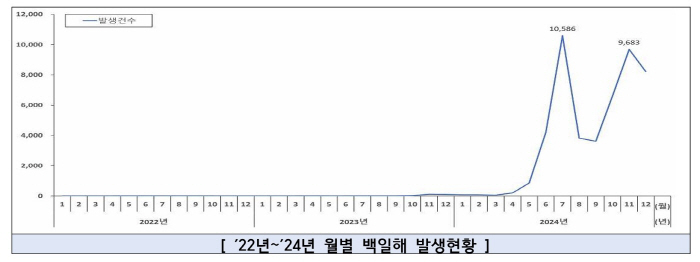54.5% of infectious diseases occurred last year due to a surge in whooping cough patients ↑
|
According to the "2024 Annual Report on Infectious Disease Reporting" published by the Korea Centers for Disease Control and Prevention on the 26th, the number of patients who reported infectious diseases (levels 1 to 3) last year was 168,586 (329 per 100,000 population), up 59,499 (54.5%) from 109,087 in 2023.
This number excludes COVID-19, which was converted from level 2 to level 4 in August 2023 and excluded from the total monitoring, and syphilis, which began to be monitored from level 4 to level 3 in January last year. Including them, the number decreased by 97% from 5,626,627 in 2023 to 171,376 last year.
According to the report status of major infectious diseases in 2024, there was one case of botulinum toxin in 2023, but there was no report in 2024.
The total number of second-class infectious diseases (21 types) was 152,586, an increase of 64.7% (59,936 people) from the previous year. Most of the major infectious diseases that increased the number of patients last year compared to 2023 were pertussis, and other four infectious diseases, including scarlet fever, chickenpox, and carbapenem endobacterial tree (CRE) infections, accounted for 84.5% (128,929 people) of all reports of second-class infectious diseases.
In particular, the number of whooping cough patients, which was only 292 in 2023, surged 164.5 times to 48,048 last year. pertussis, characterized by paroxysmal cough, was prevalent not only in Korea but also around the world last year, and an infant with pertussis died in November last year, marking the first case of pertussis death in Korea since statistics were compiled in 2011. Like whooping cough, scarlet fever, another respiratory infectious disease, was also popular among preschoolers and school-age children and adolescents, and the number of patients was reported last year to be 6,642, 8.1 times higher than the previous year. The number of chickenpox patients was 31,892, and the number of CRE infections was 42,347, up 18.3% and 10.3% from the previous year, respectively.
On the other hand, major infectious diseases that have decreased are mumps, tuberculosis, and hepatitis A. Mumps (6425 people), also called 'magicals', decreased by 17.0% compared to the previous year, and the number of patients with tuberculosis (14,412) and hepatitis A (1168) decreased by 7.9% and 11.8%, respectively. Among them, tuberculosis has decreased 7.5% annually since the number of new patients reached a peak of 39,557 in 2011, a 7.9% (1,228) decrease in 2024, but the proportion of elderly people among all new patients (4412) has steadily increased every year, accounting for 58.9% (8491) in 2024.
The total number of Class 3 infectious diseases (28 types) was 18,790, an increase of 14.3% (2.354) compared to the previous year, but excluding syphilis (2,790 people), which was converted from Grade 4 to Grade 3 in 2024, it decreased by 2.7% (436 people). The main infectious disease that increased was tsutsugamushi (6268), a tick-borne infectious disease, which increased by 10.7% last year. The main infectious disease that decreased was hepatitis C, which was reported in 64444 cases in 2024, down 11.1% (805) from the previous year.
The number of cases of infectious diseases imported from abroad was 606, an increase of 55.8% (excluding COVID-19) from the previous year. Dengue fever (196), syphilis (117), malaria (54), chickenpox (43), and hepatitis C (41). Asia (Indonesia, the Philippines, Vietnam, Thailand, etc.) accounted for about 79.5% of the total, followed by Africa (South Sudan, etc.) at 9.1% and Europe at 5.1%.
Meanwhile, the number of legal infectious disease deaths (excluding tuberculosis) last year was 1238, up 18.2% from the previous year. The infectious disease with the most deaths was CRE infection, an infectious disease caused by the so-called 'superbacteria' with antibiotic resistance, which killed 838 people. Then, acquired immunodeficiency disease (158) and pneumococcal infection (87), followed by death.
This article was translated by Naver AI translator.




